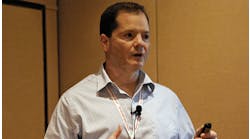“ELCN builds bridges with Ethernet, and fully synchronizes with HPM.” In full copilot attire appropriate for a ‘mid-air’ system migration demo, Honeywell’s Steven Roby walked users through the straightforward steps that have turned complicated migrations into on-process upgrades.
Hey, digital transformation, what have you done for me lately? By now, it’s fairly well-known that digitalization and the Internet can help with routine data gathering and monitoring. However, some innovators are extending digital transformation far beyond its usual capabilities to take on a bunch of new system migration, capital expenditure (CapEx) and other tasks, and deliver a host of big-ticket benefits.
Chief among these efforts are the capabilities joining C300PM controllers from Honeywell Process Solutions, which already preserve high-performance process manager (HPM) functions and port-mapped I/O (PMIO) wiring, and typically perform regulatory, sequential, batch and multivariable control functions.
“We did 100 migration projects over the course of the pandemic, so we know end-users and operators want to reduce their migration cycle times by 50% with advanced migration technologies. They want to modernize their legacy equipment and systems, so they can participate in the future of process control,” said Jason Urso, CTO, Honeywell Process Solutions. “More than two years of COVID-19 taught us new ways to work more remotely and digitally, including embedding more sensors for more analytics—similar to cars that can alert us to stay in our lanes. We’re taking 40-year-old process systems, and upgrading them in place without disturbing operations. We’re turning migrations into upgrades that can make every day the best day for production, make every worker an expert, and achieve greater sustainability, too.”
Urso presented Honeywell’s traditional technology update keynote on the second day of Honeywell User Group Americas (HUG) 2022 this week in Orlando, Fla. More than 1,200 customer attendees are here for HUG, which is marking its 45th annual, in-person event.
Digital buddies boost controller
Urso reported that C300PM and its digitalized capabilities are the latest step in Honeywell’s migration of its installed base from the legendary TDC 3000 to Experion Process Knowledge System (PKS). It’s HPM was upgraded to an Enhanced HPM (EHPM) shortly before C300PM was introduced last year. Because the controller is itself an EHPM device, it also preserves existing, built-in control strategies.
In addition, C300PM’s connectivity lets it expand access to I/O via C300 I/O Highly Integrated Virtual Environment (HIVE); integrate with subsystems via open standards like EtherNet/IP, Modbus, Profinet, TCP/IP and other protocols; and talk to Foundation Fieldbus devices, too. Most recently, EHPM capabilities in C300PM enabled Honeywell to launch EHPM eXtended (EHPMX) this week at the HUG event. EHPMX is reported to have 50% greater data access performance than EHPM and integrated security with a built-in firewall. EHPMX is scheduled to be available later this summer.
Don’t migrate, upgrade!
Urso added that many users want to emulate their legacy networks, application and interface modules in software. “All of the legacy devices can be emulated in LCN software, which eliminates traditional obsolescence and give systems infinite life,” said Urso. “In short, we’re not really migrating anymore. We’re simply upgrading, while preserving intellectual property (IP).”
Urso explains this upgrade-style migration consists of three main steps:
- Installing an Experion Station TPS (ES-T) with an intuitive, high-performance operator environment;
- Adding EHPM, EHPMX and C300PM to retain 100% of I/O, control and connectivity; and
- Converting the ELCN from hardware to software to give it infinite life, retain 100% of controls and graphics, and eliminate LCN cables and bottlenecks.
“ELCN builds bridges with Ethernet, and fully synchronizes with HPM,” added Steven Roby, senior principal software engineer at Honeywell. “Several high-level steps are required to upgrade a classic AM to ELCN AM. These include deploying a virtual ELCN node image via vSphere client, taking a fresh AM checkpoint, shutting down the classic AM from the network, powering off the main AM chassis, powering on the virtual machine, building a Control Builder platform block for ELCN AM, and loading the AM again from the HM after power up.”
Likewise, Roby advised using Honeywell’s HM Syncher technique to migrate to ELCN HM. This consists of:
- Rapidly synchronizing running HMs’ data to create ELCN HM “disk drives”;
- Temporarily changing an ES-T into an HM Syncher node;
- Using the Synch PN:xx ELCN command processor syntax from the NW command processor, which takes about one hour to sync, while the HM keeps running;
- After the command is complete, moving the disk drives from the HM Syncher node to ELCN HM node, shutting down the running HM, and restarting the ELCN HM services, so the node will autoboot; and
- Using up only five minutes of on-process HM downtime, which is the same time it takes to shutdown and reload an HM.
“These are the simple, seamless, software-based steps that can be done on-process, which make migrations more like an upgrade,” explained Urso. “It used to take a full day to migrate files to ELCN HM. Now, it just takes about five minutes of downtime.”
Capitalizing on CapEx
Just as digitalization and add-on software can streamline controllers and operations, Urso added they can also enable CapEx projects and transform the automation they employ.
“Over the last five to seven years, Experion has served as the foundation for virtual engineering and digital twin initiatives. These efforts also involve our Universal I/O, virtualization technologies, and separating software from hardware, which can save 80% on hardware,” said Urso. “We’re also checking displays and logic in digital environments, which lets users complete fixes before they land on physical systems. This is where the new generation of controls systems is emerging. It will include controls that are:
- Self-organizing and configuring for faster, lower-risk project execution;
- Possess infinite reliability and longevity, which let users buy once and last for the entire life of the asset; and,
- Rely on an intelligent advisor that provides expert assistance, and is self-diagnosing and self-correcting.
Honeywell meets these needs with its newly released self-organizing Experion HIVE components, which include:
- I/O HIVE for building modular equipment with distributed I/O that serves as an extension of devices;
- Control HIVE that integrates multiple individual controllers to one virtual controller; and
- IT HIVE, which reduces IT lifecycle costs by reducing physical IT equipment at process facilities.
“This is the seamless evolution of hardware,” said Urso. “Users can decommission old devices or add computing as needed without causing downtime. There’s no more rip and replace.”
The editors of Control, Control Design and Smart Industry are reporting live from 2022 Honeywell Users Group in Orlando, Florida, to bring you the latest news and insights from the event. When the event comes to a close, the best, most important coverage will be compiled into a report by the editors.
Register now to pre-order the report and be among the first to receive it in your inbox.






